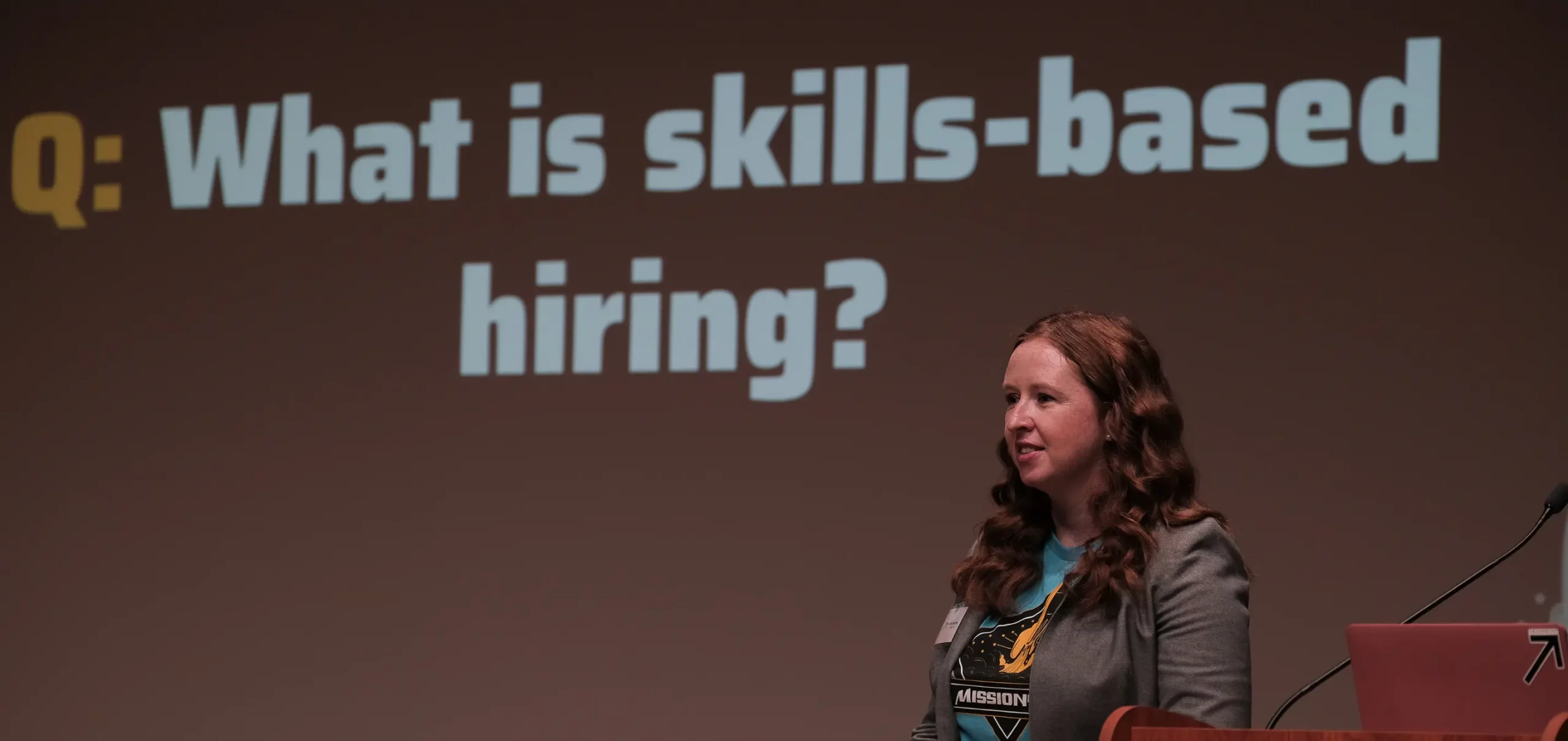Skills-First Hiring: Reflection and Motivation
Two months ago, more than 200 early adopters of TechPoint’s Mission41K gathered to learn more about to help overcome unprecedented and global talent challenges that threaten to slow central Indiana’s steady progress toward national recognition as a thriving and diverse tech hub.
It was a day-long event that included national, state and local leaders from tech, government, non-profit and community organizations coming together to listen, networking and learn from breakout sessions on modern youth and adult apprenticeships to total rewards planning and skills-first hiring. As a part of the TechPoint team who helped organize and facilitate the event, I kept track of the participants’ response to the programming.
My unscientific polling showed an overwhelming and consistent response: Indiana’s tech ecosystem was on board for making meaningful change to ensure Indiana continues to be a top tech hub. Participants left that event energized, inspired, excited and motivated. I’m still energized, inspired, excited and motivated myself.
But it’s time to move past that. It’s time to act.
To achieve our collective goal of inclusively adding 41,000 new workers to Indiana’s tech workforce, we must engage all available talent and actively fight against excluding those who have the skills necessary to be successful in tech roles but who do not have the college diplomas we’ve been incorrectly – and unfairly – insisting they have.
This bias began in the early 2000s when hiring managers began adding degree requirements to job descriptions despite the positions themselves not changing to need them. This shift away from a focus on skills-based hiring to degree-based hiring became more pronounced after the Great Recession and persists in many workplaces.
How to overcome biased hiring in tech
Skills-based hiring and promotion practices recognize all skills no matter when or where they were developed. Skills-based hiring uses competencies as the core to job postings and the hiring process structure.
It removes credential requirements whenever possible and identifies competencies even when a certain educational attainment level is needed. This helps to reduce bias in the decision-making process when screening and selecting candidates.
If we are to achieve Mission41K, we must encourage – rather than discourage – all available talent to seek, secure and grow Indiana tech professionals.
One way we’re helping the Hoosier tech sector do this is through the TechPoint Skills-First Learning Experience, which incorporates free resources and tools through a partnership with the Rework America Alliance. Cohorts who participate in this program discuss the benefits of skills-based hiring, learn how to update job postings to be skills-based and discuss what change management considerations are needed for continued progress.
Early cohort participants are already updating job postings for product managers, software engineers, and sales roles. Within weeks of taking that action, they reported benefits like more quality responses to job postings, better understanding and confidence in building job postings, especially for roles they are not as familiar with, and being connected to quality resources.
Kristi Amendola, VP, member experience, with M2N Minority Moves Network, said the workshop gave her organization valuable tools and knowledge to support clients, expand its talent pool and diversify.
“TechPoint is leading the way toward a more inclusive workforce in Indiana with their focus on skills-based hiring models,” she said.
Vaco Director of Technology Solutions Derek Lawless said the workshop was an eye-opener.
“It’s increased my awareness of the many ways organizations limit their pool of resources and has equipped me with the knowledge and tools my team needs to help our clients expand their access to all available talent in the Indiana technology ecosystem,” he said.
Amber Chandler, project manager & transformation coach at SOP Evolution, said there is “no question” about how this skills-based hiring training program will impact the workforce and influence hiring norms.
“From the content to the cadence, there’s so much intentionality that went into this curriculum. As a participant in the inaugural cohort, I foresee it being a colossal step in the right direction for matching opportunities to exceptional, untapped talent,” she said.
TechPoint is hosting additional cohorts in 2023 of our Skills-First Learning Experience, and we’d love to have you join us.
If you’re ready to join the Mission41K movement right now, check out these 6 Steps to Update Your Job Posting to be Skills-Based:
- Identify the competencies: List the competencies needed for someone to be successful in the role using the current job posting/description as a starting point or begin anew! The goal is to capture all the potential competencies needed in the role.
- Rank the order competencies: Take the list of competencies and give a number to each competency based on how important it is. For example, if you have 15 competencies you will assign each competency a number of 1 through 15 depending on the importance of the competency for the role in your company.
- Determine if competencies are occupational or foundational: Occupational competencies are specific to the job and foundational competencies can transfer from role to role as well as industry to industry. The goal is to be intentional and have a balance between the two.
- Determine employer ability to train the competencies: All competencies can be trained. Where, when and to what proficiency level depends on many factors. This step focuses on your company’s time, resources and ability to train to each competency.
- Determine if competencies are required or preferred: Required competencies are needed at some skill level Day 1 of the job. Preferred competencies are able to be trained by the company or through a partnership with an education and training partner. This better organizes the job posting and signals to job seekers as well as internal applicants what is truly required and how the company will support the individual’s skill development.
- Write inclusive competency definitions: Using the activities someone performs in the role to help define the competency gives insight into how the competency is used on the job. Be mindful of the language used to be gender neutral whenever possible.




